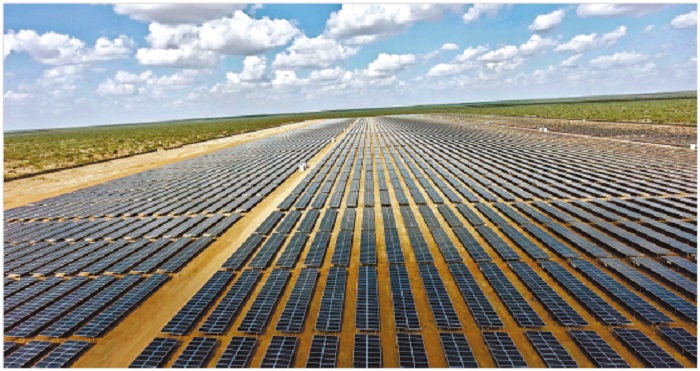



Photovoltaic power generation has grown into a new highlight of new energy development in Africa, as well as an important part of China-Africa cooperation in infrastructure construction. As the cooperation expands, more and more bulbs are being lighted in African families.
At the bank of the winding Tana River in Kenya’s North Eastern Province, a gigantic “blue sheet” is embedded on the golden savanna. The sheet, consisting of over 200,000 photovoltaic panels, covers an area of 85 hectares. It is by far the largest photovoltaic power project in Kenya, and even in East Africa. The 50 MW Garissa Solar Power Plant has largely reduced the local price of clean energy – the electricity is purchased by Kenya’s power department at 12 Kenyan shillings ($0.12) per kilowatt hours, which is 40 percent lower than the price of diesel power generation.
The project was raised by Kenya’s Ministry of Energy and financed by the Export-Import Bank of China. A consortium was established by China Jiangxi International Economic and Technical Cooperation Co., Ltd. and JinkoSolar, one of the largest and most innovative solar module manufacturers in the world, to take charge for design, purchase, construction, installation and training. The project was completed and put into operation at the end of the last year.
Mumin Gedi, Chairman of Rahma village near the project witnessed the huge changes brought by the power plant. According to him, there were only a few diesel generators in the village that lighted several shops before the photovoltaic power plant was built, and all activities had to come to an end when the sun sank. Most of the villagers chose to work outside due to the dull lifestyle, he said.
He told People’s Daily that the construction of the photovoltaic power plant not only created jobs for local people, but also taught them skills. The plant’s construction and operation brought vitality to the village and lighted up the night.
A merchant there noted that the cheap electricity and night-time economy made him wealthy. “The stable power supply realized dreams of many villagers,” he said.
Peter Mbugua, CEO of Rural Electrification and Renewable Energy Corporation of Kenya, introduced that the power plant generates nearly 88 million kilowatt hours of electricity on an annual basis, which is able to satisfy the demand of around 350,000 residents, benefitting half of the population in Garissa, capital of North Eastern Province.
Half of Kenya’s electricity is generated hydraulically, so the power supply capability of the country is severely impacted in winter. Photovoltaic power generation is a great solution to the problem. The 50 MW Garissa Solar Power Plant has received high recognition from Kenyan President Uhuru Muigai Kenyatta, who said the stable power supply will greatly drive local economy.
Larry Rambi is a farmer in Mwachiroko village, Lusaka, capital of Zambia. His cottage isn’t connected to power grid, but he’s already enjoying the convenience of electricity, as the power supply problem is resolved by a domestic photovoltaic power supply system developed by Chinese firm StarTimes.
Rambi said photovoltaic power generation has put an end to his family history of lighting kerosene lamps. “We can watch TV at night, and our children can also study. It’s great to use the solar power,” he said.
StarTimes took its off-grid micro photovoltaic business to Kenya and Zambia almost two years ago. The service has been widely welcomed by local residents thanks to its economical performance, zero pollution, durability, safety and convenience. It is totally affordable for local farmers as they can pay on an installment basis.
So far, StarTimes has expanded the business to Uganda, Tanzania and Rwanda, bringing brightness and happiness to hundreds of thousands of African families.
An International Energy Agency report noted that nearly 70 percent of the population suffering from power shortage were in Africa the last year. Before 2018, about 80 percent of enterprises in sub-Saharan Africa suffered losses from frequent blackouts. Bloomberg predicted that the market of micro photovoltaic power generation will reach $128 billion in Africa by 2030.
China, through multiple ways of financing, is supporting the construction of photovoltaic generation, transmission, transformation and power grid in Africa, in an attempt to help the continent improve power supply and propel economic growth. As the price of photovoltaic devices continues to drop, photovoltaic power generation is increasingly becoming a highlight in Africa’s new energy sector. Commercial photovoltaic solutions will be more attractive in the post-pandemic era, said Jay Naidoo, CEO of IMPower Pty Ltd., a commercial photovoltaic enterprise in South Africa.
At present, more and more competitive Chinese companies are joining the photovoltaic construction in Africa, including China Gezhouba Group Corporation which announced in February to build a 500MW photovoltaic project in Uganda, and the Power Construction Corporation of China that signed an agreement with Zambian state-owned electric utility ZESCO in May for a $548 million photovoltaic project. Currently, 30 percent of the market share in Africa’s photovoltaic sector is controlled by Jinko Solar.
Meanwhile, China is also actively building talent training and tech-transfer mechanisms for African countries, as well as renewable energy cooperation and development centers.
Chinese firms supplied high-performance parts for a 233MW photovoltaic power plant in Algeria, offered photovoltaic lighting equipment for 20 soccer pitches in Africa, and successively held two training workshops on solar technology application for the continent. Besides, China has also exported relevant technological results to multiple African countries.


The Humanitarian Service Diamond Awards has.
A Chinese Company, Inner Galaxy Steel.


The Programme Coordinator, Regulatory, Compliance and.


A Non-Governmental Organization (NGO), Committee for.
The Trustfund Pensions Limited has chided.


The House of Representatives Committee on.
The China General Chamber of Commerce.


Senator Chuka Utazi who represented Enugu.


An Abuja based Legal Practitioner, Ugochukwu.


The African business community in Yiwu,.
Leave a Comment